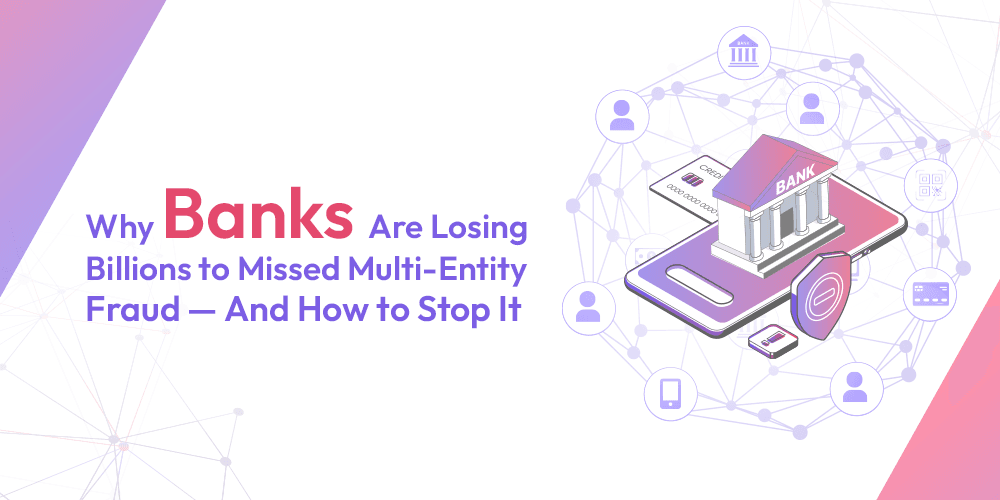
Why Banks Are Losing Billions to Missed Multi-Entity Fraud and How to Stop It
RaptorX.ai
Tuesday, July 15, 2025
In today’s hyper-digital economy, banks face an evolving and often invisible threat: fraud that doesn’t come from a single bad actor, but from interconnected webs of accounts, people, and entities. This growing menace, known as multi-entity fraud, is responsible for billions in losses across the financial sector annually.
Yet despite all the investments in detection infrastructure, the biggest issue persists: banks are still looking at fraud in silos.
Understanding the Problem: The Fraud Is in the Network
Most financial institutions evaluate transactions, accounts, and user behavior on a unit-by-unit basis. Each account is monitored individually. Each transaction is scored independently. Each flag is treated as a case on its own.
But multi-entity fraud doesn’t operate in isolation.
How Multi-Entity Fraud Works:
- Mule accounts are opened under real or stolen identities and dispersed across branches or geographies.
- Shell entities funnel money through layers of legitimate-looking payments.
- Coordination happens across multiple banks, channels, and transaction types. none of which raise alarms on their own.
- The fraudster orchestrates everything remotely, often using social engineering, proxies, and automation to mask trails.
In short, the fraud is not in the transaction. It’s in the pattern, and often, the patterns involve dozens or hundreds of touchpoints acting in sync.
Why Current Practices Are Failing
Banks are equipped to analyze risk, but not coordination.
Even the most sophisticated fraud detection teams often rely on systems that were built to detect anomalies within individual accounts or transactions. These setups struggle when:
- Fraud spans across multiple accounts or timeframes.
- Activity mimics normal customer behavior at a micro level.
- There is no obvious breach or alert-worthy action, yet damage is silently compounding.
The result? Entire fraud rings operate undetected for weeks, sometimes months, moving millions undisturbed through legitimate rails.
A Shift in Perspective: Detecting Intent, Not Just Action
To detect multi-entity fraud, banks must pivot from monitoring “events” to understanding behavior across relationships.
This is where agentic AI and graph-based intelligence bring new possibilities.
Let’s break this down:
1. Graph and Network Analysis
Rather than analyzing accounts as isolated units, graph analysis maps the relationships between entities—people, businesses, devices, accounts, transactions—and identifies hidden clusters of coordination.
For example:
- Five customers sending money to the same destination on the same day may appear coincidental.
- But if they’ve also logged in from shared IPs, used similar devices, and received prior funds from a common node, a coordinated fraud pattern begins to emerge.
These relationships can’t be caught with linear models. They require dynamic, real-time network detection.
2. Behavior and Intent Analysis
Modern threats demand systems that ask: “Is this user acting with genuine financial intent—or are they part of a coordinated funnel?”
By evaluating intent—not just deviation—banks can:
- Detect new forms of laundering through e-commerce payments, fintech APIs, or peer-to-peer apps.
- Trace back how fraud rings initiate, expand, and evolve over time.
- Anticipate fraud before money exits the network.
This is not a prediction—it’s prevention based on contextual understanding.
Real-Time, At-Scale, Self-Optimizing: The Future Is Now
One platform already delivering this capability is RaptorX. Deployed at scale in several of India’s top financial institutions, RaptorX is built to uncover multi-entity financial crimes in real time and without relying on static thresholds or pre-fed typologies.
Key Capabilities:
- Multi-entity detection at scale: Flags fraud rings, mule networks, and laundering circuits—even when individual accounts appear clean.
- Graph neural networks (GNNs): Build dynamic, evolving models of financial behavior and relationships between entities.
- Real-time pattern analysis: Surfaces coordinated activity across millions of transactions within seconds.
- Human-centered workflows: Designed for compliance and investigation teams, alerts are rich in context and explainable, not just technical.
This combination of contextual pattern recognition, multi-dimensional behavior analysis, and real-time graph computation is a leap forward in stopping financial crimes before they spread.
From Lagging Reaction to Proactive Control
The impact of missing multi-entity fraud is more than monetary. It includes:
- Regulatory penalties for delayed SAR filings or compliance gaps.
- Operational drain from manual investigations that lead nowhere.
- Erosion of customer trust when banks fail to protect legitimate users from being used as money mules.
Stopping this type of fraud requires more than patchwork upgrades—it requires a shift in philosophy. Fraud is no longer a matter of detection. It’s a matter of understanding how financial ecosystems behave in motion.
Conclusion: It’s Time to Outthink the Network
Fraud today is coordinated, camouflaged, and fast-moving.
To defeat it, financial institutions must match that sophistication, not with more rules, but with systems that see the bigger picture, faster.
Multi-entity fraud isn’t an anomaly; it’s the new normal. And ignoring it comes at a rising cost.
Solutions like RaptorX provide a real-time, scalable response, allowing banks to move from fragmented detection to unified, behavior-aware defense.

